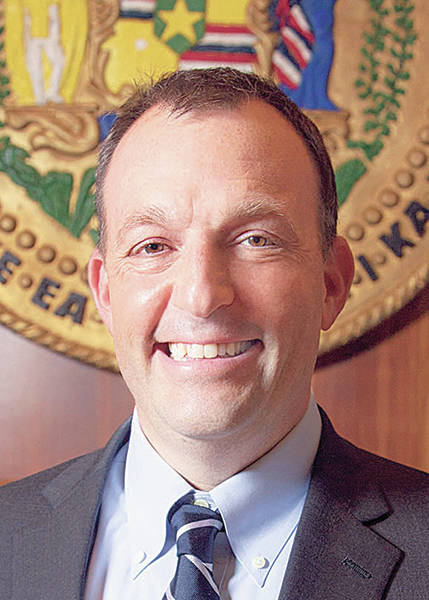Lt. Gov. Josh Green vowed Wednesday to continue his message of greater social distancing, more coronavirus testing and stricter laws to cut off the deadly disease before it overtakes the islands — regardless of what’s been going on in state Capitol corridors.
Green, in a back-and-forth session by videoconference with the Hawaii County Council, shrugged off media reports that Gov. David Ige banned him from Capitol press conferences and ordered other state officials not to consult with him. Ige earlier this month named Green, a practicing physician, the administration’s liaison between the state and health-care community.
The outspoken Green has consistently pushed a cautious administration to be more aggressive in stopping the virus, recommending keeping cruise ships from entering ports, quarantining visitors coming in from the mainland and other countries and instituting stay-at-home directives for residents, in addition to more broad-based coronavirus testing.
“I don’t worry about that kind of thing. …Can you imagine for one second that I’m not going to fight for one second to save lives,” Green asked. “I do my best to share what I think will save lives, and if they don’t accept that, I share it with the entire planet and then they catch up later. … I refuse to not be heard.”
Green, a Big Island physician who previously represented West Hawaii as a Democrat in the state House and Senate, is running for governor in 2022. Ige, also a Democrat, is term-limited and can’t run again.
The state has since adopted most of Green’s recommendations to some extent. Cruise ships have stopped, visitors will be quarantined starting today and a stay-at-home order began Wednesday. But Green said too many exemptions from the stay-at-home order dilute its effectiveness and will likely lead to more cases.
“I have to be at the tip of the spear,” Green said of his work getting reports from the state’s hospitals, formulating recommendations and transmitting them to the administration. He’s not part of the central COVID-19 incidence command, although he does correspond with its head, Maj. Gen. Kenneth Hara, he said.
“If people don’t feel they have the capacity or courage to do it right then, I’m going to give them advance notice,” he said.
Ige responded in a Wednesday afternoon press conference that Green’s role has not changed. He was named liaison to work with the hospitals to evaluate their needs and help them secure necessary equipment, Ige said.
“I welcome the advice and suggestions from Lt. Gov. Green as well as anyone else on how we protect our community,” Ige said, adding that his highest priority is to protect people’s health and “anything else at this time is an unnecessary distraction.”
“I ask everyone to put aside their personal agendas,” Ige added.
State Department of Health Director Bruce Anderson, formerly president and CEO of Hawaii Health Systems Corporation, has served as the state epidemiologist. He and current State Epidemiologist Sarah Park are usually the ones standing with Ige at press conferences and responding to questions.
Longtime State Rep. Cynthia Thielen, an Oahu Republican, on Tuesday called for an emergency session of the state Legislature to name Green the state COVID-19 director.
“Hawaii is extremely fortunate to have a Lt. Governor who not only is a medical doctor but who has worked in public health. Lt. Gov. Green is absolutely the right person to lead our state out of this very serious and frightening emergency. To silence him because of political or other reasons is a travesty,” Thielen said in a press release.
Green is taking the pandemic seriously. Stop the spread of the virus before it gets a greater hold, and more people will survive it, he said. The economy will take a shorter-term and less devastating hit if strict measures are taken now, he said.
“We should absolutely just rip the bandage right off,” and then use stimulus packages to, “jolt the economy like we jolt a cardiac patient,” he said.
The state reported 95 COVID-19 cases Wednesday, up from 90 the previous day.
Broad-based testing is important in order to identify clusters of infection and make plans for locating surge facilities to handle the overflow, Green said.
Anderson, during a session with the County Council on Friday, said “the job’s being done.”
“It’s not a case where we can test everyone,” he said. “We know what’s happening out there.”
The numbers are bleak. The state has 2,855 licensed hospital beds, 309 ICU beds and 418 ventilators, according to the Healthcare Association of Hawaii. The Big Island has 295 licensed hospital beds, 24 ICU beds and 39 ventilators.
The state is 22% under capacity in health-care workers, while the Big Island is a grim 40% short.
Green predicts the virus will peak between April 15 and 25 before dropping off, as long as people stay away from each other. Worst case scenario would be if the health-care system is overwhelmed, as Green said is happening in some states, where cases are triaged, denying scarce ventilators to those over 80, over 70 and even over 60, as their survival chances are lower. Generally 3% of COVID-19 cases die, compared to 8% for those 80 or older.
“When 500,000 people suddenly get sick and 5% need serious care … we would have to choose who to take care of,” he said. “I don’t want to be overly alarmist. … We must absolutely, absolutely isolate at home at this time. … If people isolate at home, the spread will go down very quickly … and then it burns out.”






